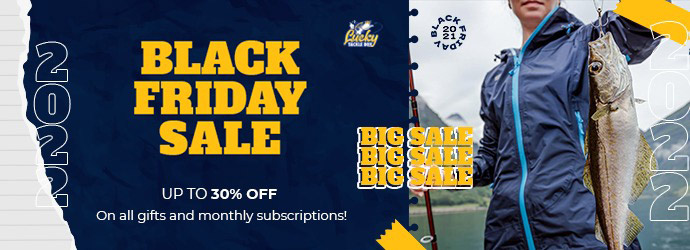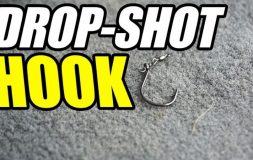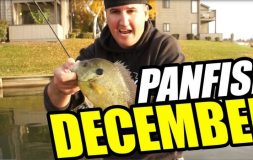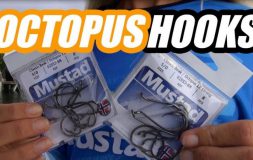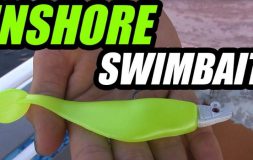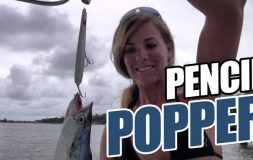Going heavy undercover with flipping jigs
It’s a great time to go heavy undercover flipping for bass in this killer instructional video from Lucky Tackle Box. Hosted by Travis Moran, we spotlight the Super Razor Beetle, a beaver-style bait that gives a ton of action to your jigs as a trailer. Docks, pilings, weeds, bushes or trees, getting deep into the cover you’re fishing is super important. Find out why!
* Transcript below:
Whoa! There we go. Woo! This fish just came out of nowhere. What is up, guys? Look at that. How about we start the video with a fish catch? I know you guys like that. And today, we’re throwing the Deep Creek Lures, the Super Razor Beetle. That’s what I’m talking about, great little profile. You could throw this on a chatter bait. You can throw it on a punch rig. But today, we’re throwing it on a little flipping jig because we’re gonna be targeting heavy structure.
Let’s let this bad boy go. Go a lot- Oh. And we got another jump out of him. Guys, when we’re talking about structure, we’re gonna talk about vertical structure. That can be anything from these trees. Look at these giant rows of trees here. It can be tule banks, targeting the different sides and positioning those tules that cover the water column. Or it can be one of my favorites, dock pilings. You’ve got the dock shade. You’ve got these pilings coming down. Fish love to relay to them. So whatever you guys like to do, however you like to fish it, this little Deep Creek Lures Super Razor Beetle is perfect paired up with the jig. Let’s break it down a little bit more, starting with rigging.
Okay, first lets talk about this bait. Great little profile. Perfect bite size for any kind of little Blue Gill, little Sun Fish these fish are feeding on, but also the crawdad. And that’s what the color are really mimicking on this as well. Now, we’ve got these little flapper pinchers. As I’m shaking this bait, it’s gonna be flapping and we’ve got what they call little razors. All these little phalanges, these little segments on it, this is displacing water. As this baits moving, it’s catching water. We’re really calling in those fish and triggering those strikes.
Then, I pair it up with a half ounce flipping jig. You can go a little heavier, a little lighter, if you want. I’m going green pumpkin. You do not have to match your skirt to these baits. You can switch up and experiment with what you want. All I do is I just thread this jig right on the bait here, come out, I kinda want that bair to sit nice and flat. And boom. There you go. This bait, I want to sink on semi-slack line so that way it’ll sink like this. I don’t really want it sinking like this. I want it kinda sinking like this. You ever seen a crawdad fall in open water? It has that real vulnerable look. It’s legs are out and it just looks awkward. And that’s what we’re trying to mimic. That’s what we’re trying to mimic cause those bass look for that and absolutely love a free meal.
And then, as this bait hits the bottom, as we’re jerking it, as we’re hopping it, this bait is gonna be kicking and when it stops down at the bottom, that skirt is gonna flare up. It’s gonna give it some movement. That fish is nosing down and hopefully trigger their strikes for you.
Now, with the gear, we need a heavy set up. I’ve got the power stick right here, which is a seven foot six heavy moderate action rod. So that’s allowing me to really control these heavier jigs and put them into the places I need to get them into. And then, when I get hooked up, I have enough power to be able to really horse this fish outta there.
Lastly, the line. We’re going that thick nasty stuff, so the thicker it is, the heavier the line you need. Today though, we’re using fluorocarbon instead of braid. We got a little bit clearer water, so I wanted to use something that was a little less visible. But normally, if I got dark stained water, I’m gonna use braid, I’m gonna use 50-80 lbs braid. With line, I’m gonna use a 20 lbs fluoro. I would never go lower than fifteen to seventeen lbs, but I have no problem going all the way up to 25 lbs fluorocarbon as well.
Hi guys, with retrieval there’s a few different things going on. But first off, I wanna make accurate casts right up alongside by structure and then I want that bait to fall right down next to it. And I have to be paying attention to see if I get bit. Once it hits the bottom, I’ll hop it once or twice. Hop, hop, and shake it a couple of times, and then I’ll go on to the next target.
Now, I’m trying to get bit on the fall. So it’s important that that thing is falling right near the structure I’m looking for. And if I don’t see myself getting bit, I’m gonna hop it away from that cover. And then, if nothing, go to the next spot.
But guys, what’s happening is it’s very target-specific, okay? I’m trying to get this bait in the strike zone cause I got a lot of structure to cover, so it’s very important you make accurate casts. You gotta flip, cast, whatever, right next to that vertical structure. That bait needs to fall right down along front of it, and if there’s a fish somewhere relating to that, he’s gonna see it next to that structure. It falls down. You’ve gotta watch your line. If it hops, that means you got bit, set into that fish. If you don’t, if it hits the bottom, you wanna shake it a little bit, hop, shake it, hop, and I usually do it two to three times and then I’m off to that next target.
And while I’m doing that, I’m usually looking for my next cast so I already know once I reel in and I’m done with that cast, I already know where my next cast is going.
Alright, when I’m fishing a jig like this, I’m looking for specific targets. And I mentioned it earlier, vertical structure. That can be a wide variety of things. That can be docks, dock pilings, sea walls, tules, trees, any kind of wood. Really anything that goes from the bottom of the water column, up to the top. And there’s a lot of reasons why bass like this.
The first is this is a great place for bait fish, for smaller little fish to hang out. They can hide and everything, and that’s where they’re gonna live, so that’s where the bass are gonna hang out as well because they wanna eat those little guys.
The other thing is, it offers them shade. They can always find that shady spot of that vertical structure and get some cooler water, but also they can hide behind there and ambush all that little activity that’s in the area cause they’re always looking for an ambush point or a place that they can pin the bait up against. In open water, that bait can escape from a bunch of different areas, but if there’s a sea wall or some kind of piling, that fish knows if a little school fish comes over that right by that piling, they can pin up right on there.
And then the last thing is, those fish can move up and down in the water column, right? So, as the barometric pressure changes, as the temperature changes, these fish wanna get into different water depth. They either have to move up the bank into shallower water or down into deeper water, or on these vertical structures, they can just move up and down. They don’t have to move away from their area.
So now, once you understand what you’re looking for in vertical structure, the other thing is that fish relate to vertical structure. They’re not always right up on it. So, in the early morning, late evening, fish will actually span out. They’ll hunt around everything. That low light. They can really … even in the wind and stuff, too, they’ll venture out a little bit more. But when you got those high skies, when you’ve got the sun out and it’s real hot and you got those hard shade lines, those fish’ll tuck right up into that structure, and that’s where you can really have a lot of success with this. When it’s a hot day out and you wanna be in the shade, so do those bass. They’re hunkered down in there and with a technique like this, that jig, you can slide it right in, you can fall right along that structure, and that’s what I’m looking for.
Today, I’ve been throwing right along the trees basically going back and forth from flipping it way up in the root system of the trees and then out more on the branches out on the outside here. They tend to be all in the same spot. If they’re all at the roots, keep casting the roots. If they’re at the trees, the outer branches, cast at the outer branches, but you’ve always gotta be switching it up and figuring out what these fish are doing.
Getting in these little holes by whatever means necessary. Sometimes you gotta skip it. Sometimes you gotta flip it. Sometimes you gotta do a combination of the two, but the idea is if you can get in there, some of these … Harder spots, there we go! You can be rewarded, cause there’s gonna be a lot of areas where other fisherman are not getting to. The harder it is to cast in there, the less likely other people are fishing it.
But anyway guys, great little technique. I had a fun day out fishing. Deep Creek Lures, Super Razor Beetle, great little bait. Like I said, you can do a punch rig. You can do chatter bait, but today I put it on a jig. I like that soft little fall. Great little crawdad profile. I hope you enjoyed it.
And if you did, make sure you hit that thumbs up and subscribe to Lucky Tackle Box. Guys, it was a pleasure fishing with you. Until next time, I’ll catch you out on the water.


